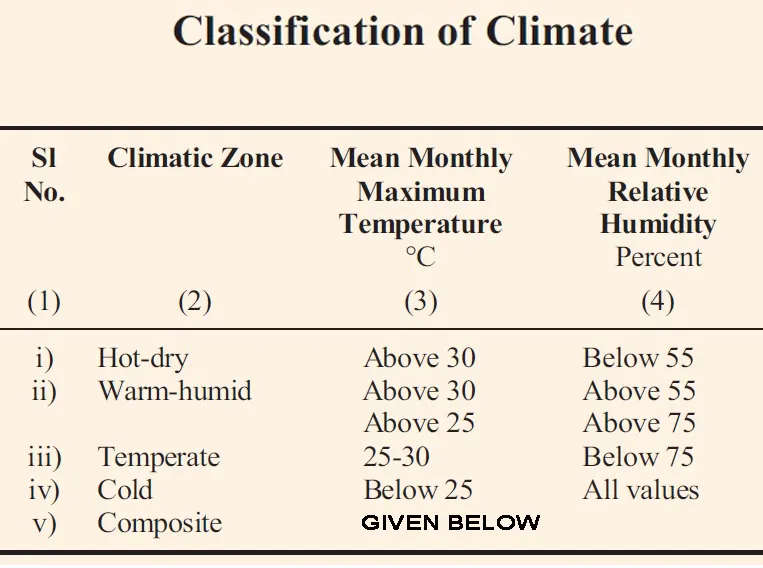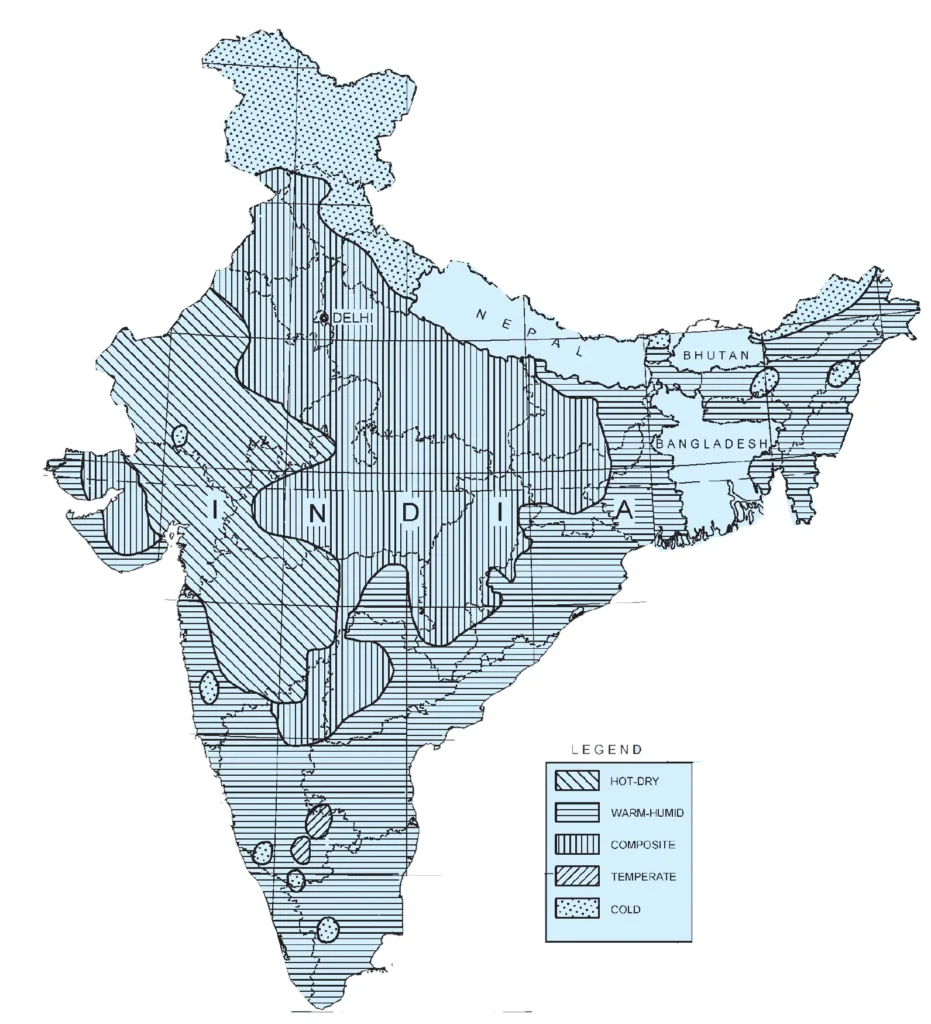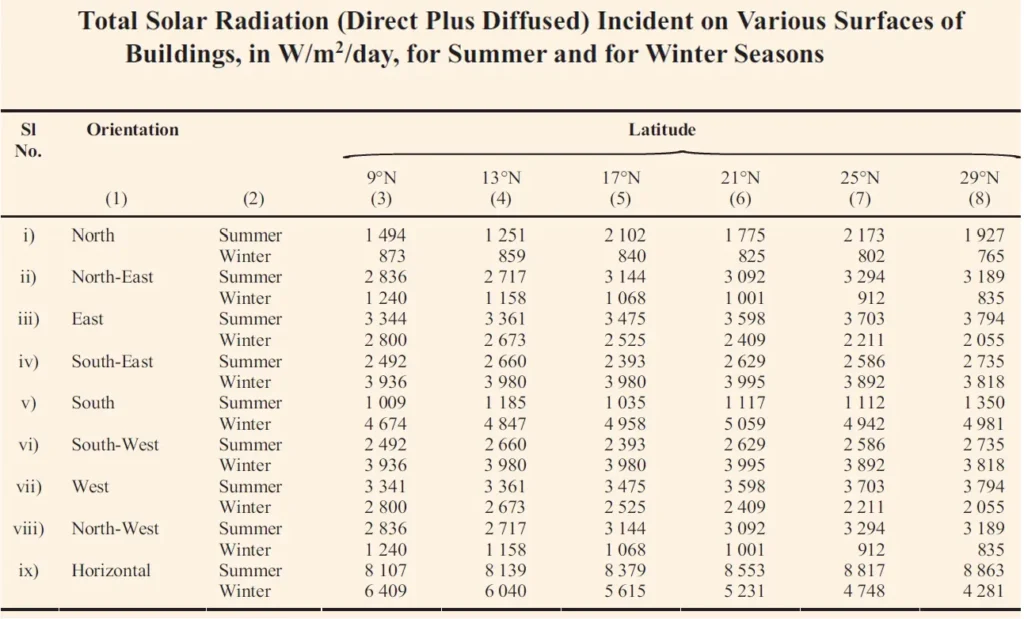If you want to know about the building orientation for passive design or principle of daylighting design or active and passive solar architecture, please click the link.
The orientation of a building with respect to climate is an important consideration in building design and construction. The orientation refers to the direction in which the building faces and how it is positioned on the site. The orientation can impact the amount of sunlight and shade the building receives, as well as the amount of wind and precipitation it is exposed to.
Orientation of building
- The chief aim of orientation of buildings is to provide physically and psychologically comfortable living inside the building by creating conditions which suitably and successfully ward off the undesirable effects of severe weather to a considerable extent by judicious use of the recommendations and knowledge of climatic factors.
1) Basic climate zones
- For the purpose of design of buildings, the country may be divided into the major climatic zones as given in Figure below, which also gives the basis of this classification.

The climatic classification map of India is shown in Figure below.

- Each climatic zone does not have same climate for the whole year; it has a particular season for more than six months and may experience other seasons for the remaining period.
- A climatic zone that does not have any season for more than six months may be called as composite zone.
2) Climatic Factors
From the point of view of lighting and natural ventilation, the following climatic factors influence the optimum orientation of the building:
- Solar radiation and temperature,
- Relative humidity, and
- Prevailing winds.
3) Solar Radiation
- The best orientation from solar point of view requires that the building as a whole should receive the maximum solar radiation in winter and the minimum in summer.
- For practical evaluation, it is necessary to know the duration of sunshine, and hourly solar intensity on the various external surfaces on representative days of the seasons.
- The total direct plus diffused diurnal solar loads per unit area on vertical surface facing different directions are given in Table below for two days in the year, that is, 22 June and 22 December, representative of summer and winter, for latitudes corresponding to some important cities all over India.

- From Above Table, the total heat intake can be calculated for all possible orientations of the building for these extreme days of summer and winter.
- Except in cold climatic zone, suitable sun-breakers have to be provided to cut off the incursion of direct sunlight to prevent heat radiation and to avoid glare.
4) Relative Humidity and Prevailing Winds
- The discomfort due to high relative humidity in air when temperatures are also high can be counteracted, to a great extent, by circulation of air with electric fans or by ventilation.
- In the past, simultaneously with heavy construction and surrounding Verandahs to counter the effect of sun’s radiation, there was also an over emphasis on prevailing winds to minimize the adverse effects of high humidity with high temperatures.
- With the introduction of electric fan to effectively circulate air and owing to taking into account the rise in cost of construction of buildings, emphasis should be placed on protection from solar radiation where temperatures are very high.
- When, however, there is less diurnal variation between morning and mean maximum temperatures along with high humidity, as in coastal areas, the emphasis should be on prevailing winds.
- For the purpose of orientation, it is necessary to study the velocity and direction of the wind at each hour and in each month instead of relying on generalizations of a month or a period or for the year as a whole. This helps to spot the right winds for a particular period of day or night.
- It is generally found that variation up to 30° with respect to the prevalent wind direction does not materially affect indoor ventilation (average indoor air speed) inside the building.
- In hot-dry climate, advantage can be taken of evaporative cooling in summer to cool the air before introducing it into the building. But in warm humid climate, it is desirable either to regulate the rate of air movement with the aid of electric fans or to take advantage of prevailing winds.
5) Aspects of daylighting
- Since the clear design sky concept for daylighting takes care of the worst possible situation, orientation is not a major problem for daylighting in buildings, except that direct sunshine and glare should be avoided.
- However, due allowance should be given to the mutual shading effects of opposite facades.
6) Planting of trees
- Planting of trees in streets and in open spaces should be done carefully to take advantage of both shades and sunshine without handicapping the flow of natural winds.
- Their advantage in abating glare and in providing cool and/or warm pockets in developed areas should also be taken. Some trees shed leaves in winter while retaining thick foliage in summer.
- Such trees will be very advantageous, particularly where southern and western exposures are concerned, by allowing maximum sun during winter and effectively blocking it in summer.
For detailed information regarding orientation of buildings please click here
Overall, building orientation is an important consideration in designing energy-efficient and comfortable buildings that respond to the local climate.